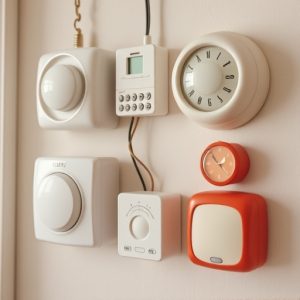Wearable Security Systems: Enhancing Outdoor Safety with Personal Alarm Sound Radius
Wearable security systems with panic features and Personal Alarm Sound Radius (PASR) enhance persona…….
Wearable security systems with panic features and Personal Alarm Sound Radius (PASR) enhance personal safety outdoors, especially during solo activities like hiking or late-night walks. These discreet devices provide swift access to help in emergencies, offering enhanced protection in diverse outdoor settings. Strategic deployment considerations include assessing environmental factors, creating defined activation boundaries, and integrating movement or orientation detection for optimal PASR effectiveness.
“Wearable security systems equipped with panic features are transforming personal safety, especially outdoors. This article delves into the workings and advantages of these innovative devices, highlighting their potential to enhance outdoor safety significantly. We explore the concept of a Personal Alarm Sound Radius, examining how it amplifies protection in open spaces. Furthermore, practical strategies for deploying these features effectively outdoors are provided, offering valuable insights for anyone seeking enhanced personal security.”
- Understanding Wearable Security Systems: How They Work and Their Benefits
- Personal Alarm Sound Radius: Enhancing Outdoor Safety
- Implementing Outdoors: Strategies for Effective Deployment of Wearable Panic Features
Understanding Wearable Security Systems: How They Work and Their Benefits
Wearable security systems, often equipped with panic features, are innovative devices designed to enhance personal safety. These systems typically consist of a small, discreet device worn on the body, which can be triggered in case of distress or an emergency. When activated, it emits a powerful personal alarm sound within a specified radius, alerting nearby individuals and potentially deterring hazardous situations. The device’s design allows for easy accessibility, enabling users to quickly activate the alarm even in challenging outdoor environments.
Beyond their ability to signal for help, these wearables offer numerous advantages. They provide peace of mind, knowing that assistance can be summoned swiftly. This is particularly beneficial during solo activities like hiking, running, or late-night walks. Moreover, their compact size makes them suitable for various scenarios, from personal protection at events or in unfamiliar places to emergency response in remote areas where other communication methods may fail.
Personal Alarm Sound Radius: Enhancing Outdoor Safety
Wearable security systems with panic features have revolutionized personal safety, especially outdoors where unexpected situations can arise. One notable aspect is the Personal Alarm Sound Radius (PASR), designed to amplify the reach and effectiveness of personal alarms in open spaces. This feature ensures that help can be summoned promptly from a distance, making it ideal for outdoor enthusiasts, commuters, and individuals living or traveling in areas with limited visibility or coverage.
The PASR works by projecting a loud, distinct alarm sound over a wide area, capturing the attention of nearby people and potentially deterring potential threats. This enhanced radius can provide an extra layer of protection during solo hikes, late-night runs, or even when attending outdoor events, ensuring that individuals can maintain a sense of security while enjoying the outdoors.
Implementing Outdoors: Strategies for Effective Deployment of Wearable Panic Features
When deploying wearable panic features outdoors, strategic considerations are essential for effective activation and response. One key aspect is defining an optimal personal alarm sound radius. This involves assessing the surrounding environment, including proximity to public spaces, potential hazards, and noise levels from urban hustle and bustle. A well-designed alarm should have a range that ensures help can arrive promptly while avoiding false triggers from ambient sounds. For instance, in quiet suburban areas, a wider radius might be suitable, whereas dense city centers may demand a more narrow one.
Implementing invisible outdoors barriers like fences or walls can enhance the system’s effectiveness by creating defined boundaries for activation. Additionally, integrating features that detect sudden movements or changes in orientation can trigger alarms even if the wearer is unable to press a button. These strategies ensure that wearable panic devices serve their purpose by providing peace of mind and rapid assistance during emergencies outdoors.
Wearable security systems with panic features offer unprecedented personal safety, especially in outdoor environments. By understanding how these devices work and strategically deploying them, individuals can enhance their personal alarm sound radius outdoors, providing peace of mind and effective protection against potential threats. Implementing these systems thoughtfully ensures maximum benefits, making them a valuable addition to any safety strategy.


